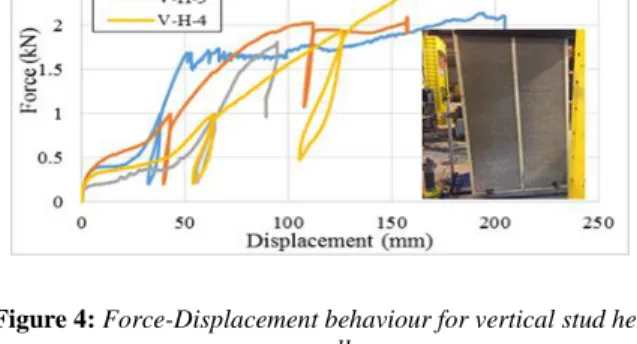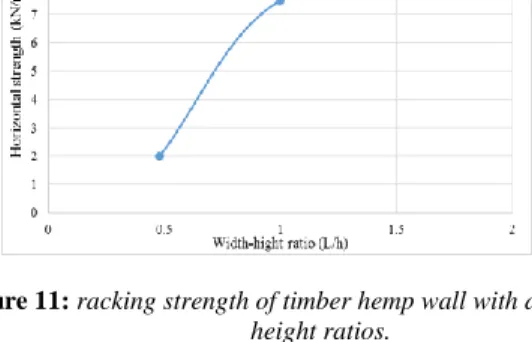1
36èmes Rencontres de l’AUGC, ENISE/LTDS, Saint Etienne, 19 au 22 juin 2018Racking behaviour of timber walls filled with hemp concrete
H. Wadi
1,2, S. Amziane
1,2, E. Toussaint
1,2, M. Taazount
1,21 Université Clermont Auvergne, Institut Pascal, BP 10448, F 63000 CLERMONT-FERRAND, FRANCE 2
CNRS, UMR 6602, IP, F-63178 Aubière, France.
husam.wadi@etu.uca.fr
sofiane.amziane@uca.fr
evelyne.toussaint@uca.fr
mustapha.taazount@uca.fr
RÉSUMÉ.
Cette étude met l’accent sur le comportement mécanique des murs en bois remplis par du béton du chanvre sous un chargement latéral. Une étude expérimentale de grande échelle des murs en bois a été menée afin de déterminer leurs résistances latérales globales, et également de quantifier l’impact du béton végétal de remplissage sur la capacité portante des murs en bois. Les éléments diagonaux sous compression et les éléments verticaux ont été employés dans les murs en bois pour investiguer les effets de la rigidité globale du système sur la résistance latérale des murs comportant du béton végétal. La technique de corrélation d'image numérique (DIC) a été utilisée afin de déterminer la déformation de cisaillement induite dans le matériau de remplissage. En se basant sur les résultats des essais expérimentaux, cette étude confirme d’abord que le panneau en bois (système de moindre rigidité) permet de montrer la faible part de la contribution du matériau de remplissage (béton de chanvre). Par contre, le mur en bois avec la diagonale de contreventement n’a pas montré la contribution du matériau de remplissage à cause de la grande rigidité du système global. Finalement, on met en évidence que le rapport largeur-hauteur du mur en bois a une influence importante dans la contribution du chanvre à la résistance du mur.
ABSTRACT.
This paper focuses on the mechanical behaviour of timber walls filled with hemp concrete under lateral loading. An experimental study of large-scale timber walls was carried out to determine the overall lateral load resistance and also the enhancement of hemp concrete to the in-plane racking strength of timber walls. Diagonal struts under compression and vertical struts were employed on the timber walls to investigate the effects of the rigidity of the overall system on the lateral resistance of hemp wall. Digital Image Correlation (DIC) technique was used in order to determine and track the shear strains. Based on the data and results obtained from the experimental tests, this study confirms that timber wall with vertical strut (system with less rigidity) allows to display small part of the continuation of filling material (hemp concrete), in contrast, timber wall with diagonal bracing did not show any contribution of the filling material due to the high rigidity of the overall system. Finally, the width- height ratio of the timber wall has an important influence in hemp concrete contribution in the lateral strength of the wall.
KEYWORDS: Hemp concrete, Timber walls, Racking strength, width-height ratio of wall.
2
36èmes Rencontres de l’AUGC, ENISE/LTDS, Saint Etienne, 19 au 22 juin 20181. Introduction
The use of low carbon material in structures improves the insolation level and sound absorption and also decreases the weight of building. In response to this need, the use of bio-aggregate such as hemp shives is increasing in Europe and especially in France [1]. Hemp concrete is now used in construction as a sustainable and carbon neutral infill wall material around timber-framed construction [2]. In-plane racking strength of timber walls is important in construction for resisting lateral loads [3]. As limited studies are published on the lateral strength of hemp walls, the aims of this work are to study the contribution of hemp concrete in lateral strength of the wall on one side-and to investigate the most effective parameter that plays a main role in the in-plane racking strength of hemp walls on the other side.
2. Theoretical analysis of timber wall units
Two different shapes of timber walls made of sawn wood of class C24 were considered in this study in order to investigate the participation of hemp concrete as infill material, vertical and diagonal bracing struts (see Figures 1 and 2). The dimensions of all tested walls were 2.5 m high, 1.2 m width and 140 mm thickness. We assume a linear elastic behaviour of the wall-unit and the deformations are caused by external force only. By applying the virtual work transformation by unit-load theorem (F), the total displacement of the wall unit ( can by calculated as:
(1)
where W is the elastic strain energy stored in the wall and provided by an external horizontal F load applied on the wall unit (Fig. 1&2). In the present case, the total strain energy consists of a normal load (N), a shear load (V) and a moment (M) as illustrated in equation (2). By taking the material characteristics into account, the vertical strut wall, the total horizontal displacement (see Equation 3) can be calculated as a function of the internal forces (equation 4) and the term F/ = 0.0083 (kN/mm). For the diagonal bracing strut wall, equation (5) is used to calculate the lateral displacement of the wall , also the term F/ = 2.7 (kN/mm)
Figure 1: Vertical strut wall unit Figure 2: Diagonal bracing strut wall unit
(2) (3) (4) (5)
Where E0,05, E0,mean are: fifth percentile value of a stiffness property and parallel to the grain elastic modulus
respectively, Gmean the mean value of shear modulus.
3
36èmes Rencontres de l’AUGC, ENISE/LTDS, Saint Etienne, 19 au 22 juin 20183. Experimental study of racking tests
Seven walls of hemp concrete were casted with the same mix proportion and same protocol of casting. All walls were tested in the same test set up to investigate the lateral load bearing capacity. The lateral load was applied for all walls at a constant rate of displacement equal to 5mm/min with a cyclic loading regime in three cycles. Digital Image Correlation (DIC) technique was used to measure and track local shear strain fields from a set of images. Images were stored each 10 seconds. The shear strain measurements were measured at a global horizontal displacement at the top of the wall equal to 50 mm. Load-displacement curves are presented in Figures 3 to 6 for the different configurations tested. Figure 7 shows the zone studied with DIC and Figure 8 and 9 give an example of shear strain field.
Figure 3: Force-Displacement behaviour for frame only. Figure 4: Force-Displacement behaviour for vertical stud hemp
wall.
Figure 5: Force-Displacement behaviour for diagonal
bracing walls.
Figure 6: Force-Displacement behaviour for diagonal bracing
hemp walls.
4
36èmes Rencontres de l’AUGC, ENISE/LTDS, Saint Etienne, 19 au 22 juin 2018Figure 7: The zone of measurements
by camera in timber walls filled with hemp concrete.
Figure 8: Shear strain field of hemp
concrete in vertical stud timber wall (V-H-2)
Figure 9: Shear strain field of hemp
concrete in diagonal bracing timber wall (D-H-2)
4. Discussion
According to the test results, it is obviously that filling material does not contribute in the racking strength of timber wall especially with diagonal bracing elements. The diagonal strut increases the rigidity of the overall system preventing the filling material to participate in the lateral strength of the wall as illustrated in Figure 6. However, a small participation of hemp concrete was noticed in vertical strut wall as presented in Figure 4. Apparently, the filling material does not work completely against lateral loads due to the absence of compression diagonal zone (Figure 8). It has been shown (see Figure 11) that the diagonal zone is related to the external dimensions of the wall (width-height ratio). In this study, the width-height ratio (L/h) was 0.48 and the average racking strength of wall was 2kN/m. An experimental test on hemp wall has been investigated by Gross [3]. In this study, the width-height ratio (L/h) was equal to 1 and the average raking strength was 7.5kN/m. Hans [4] studied hemp walls with a width-height ratio (L/h) equal to 1.9 with an average raking strength 8.9 kN/m. Figure 11 summarizes the results of these studies and confirms the significant influence of width-height ratio on the racking strength.
Figure 10: Loaded state of vertical stud hemp walls. Figure 11: racking strength of timber hemp wall with different
width-height ratios.
5. Conclusion
In this study, an experimental investigation of the racking performance of hemp walls has been conducted. The results show weak hemp participation against lateral loads. However, several studies found that hemp concrete has a high racking strength. In fact it cannot be generalized that hemp concrete has always a significant strength in timber wall. The filling material could not work mechanically against lateral load without a complete form of compression diagonal zone which make the material loaded under shear forces. This zone is related to the dimensions of the wall and is present when L/h ≥1. Within this limit, the material mechanically works, otherwise, the results are totally different.
6. References
[1] Amziane S, Arnaud L, editors. Bio-aggregate-based building materials: applications to hemp concretes. London, Holboken: ISTE Ltd., John Wiley & Sons; 2013.
[2] Lawrence M. A review of the state of the art of hemp-lime, theory, practice and current research. Bath: BRE CICM; 2009.
[3] Christopher G, Pete W. Racking performance of timber studwork and hemp-lime walling. Construction and Build Materials 2014; 66: 429–435.
[4] S. Hans, F. Sallet, L. Goudet,


